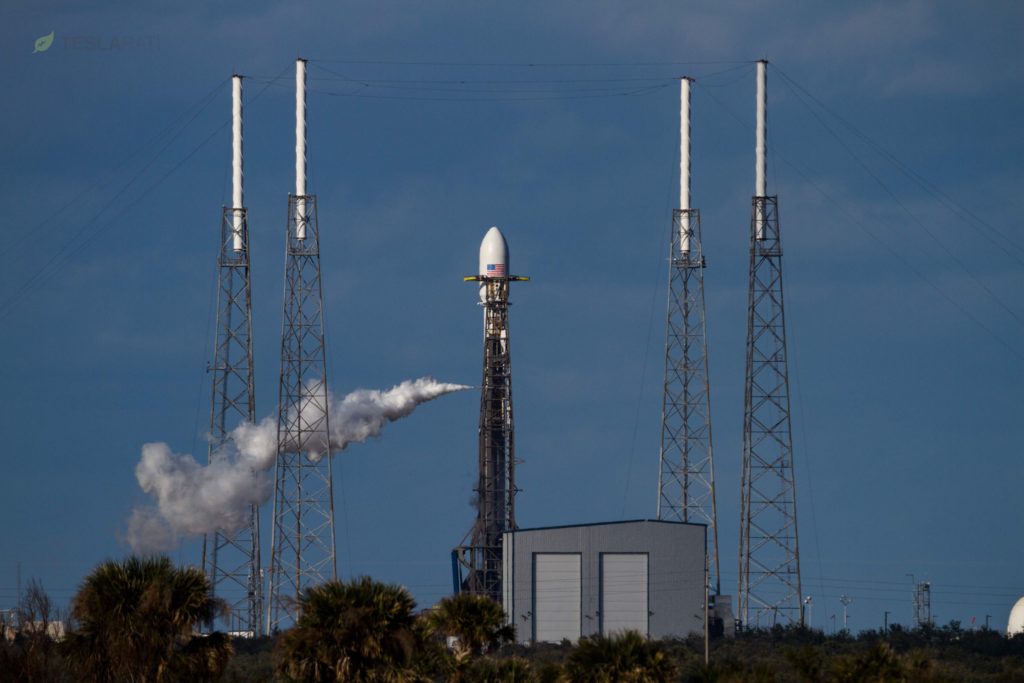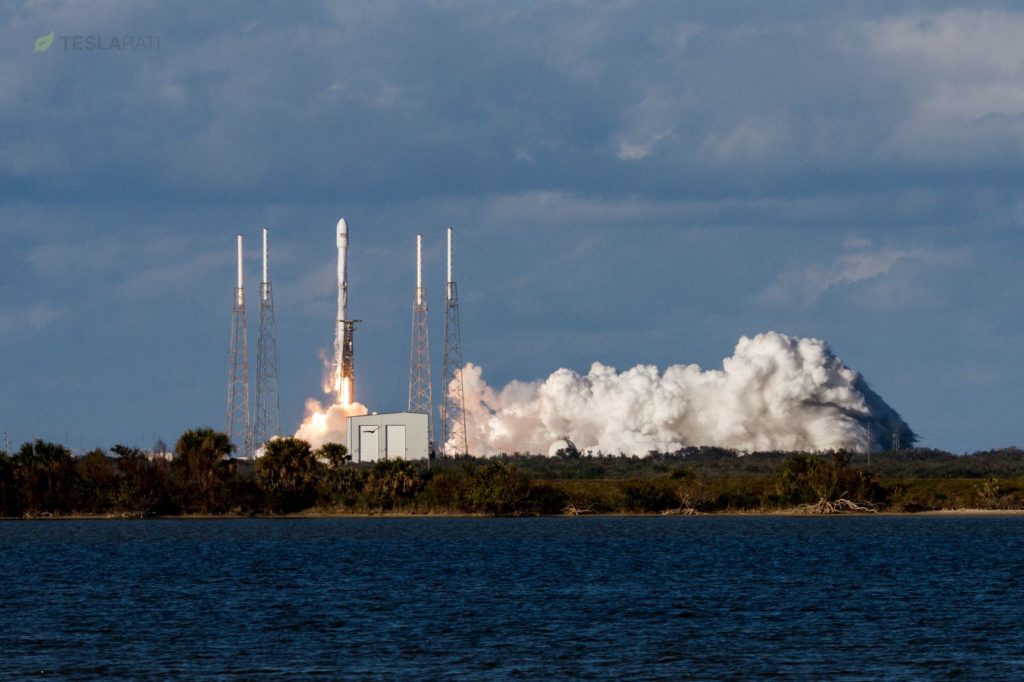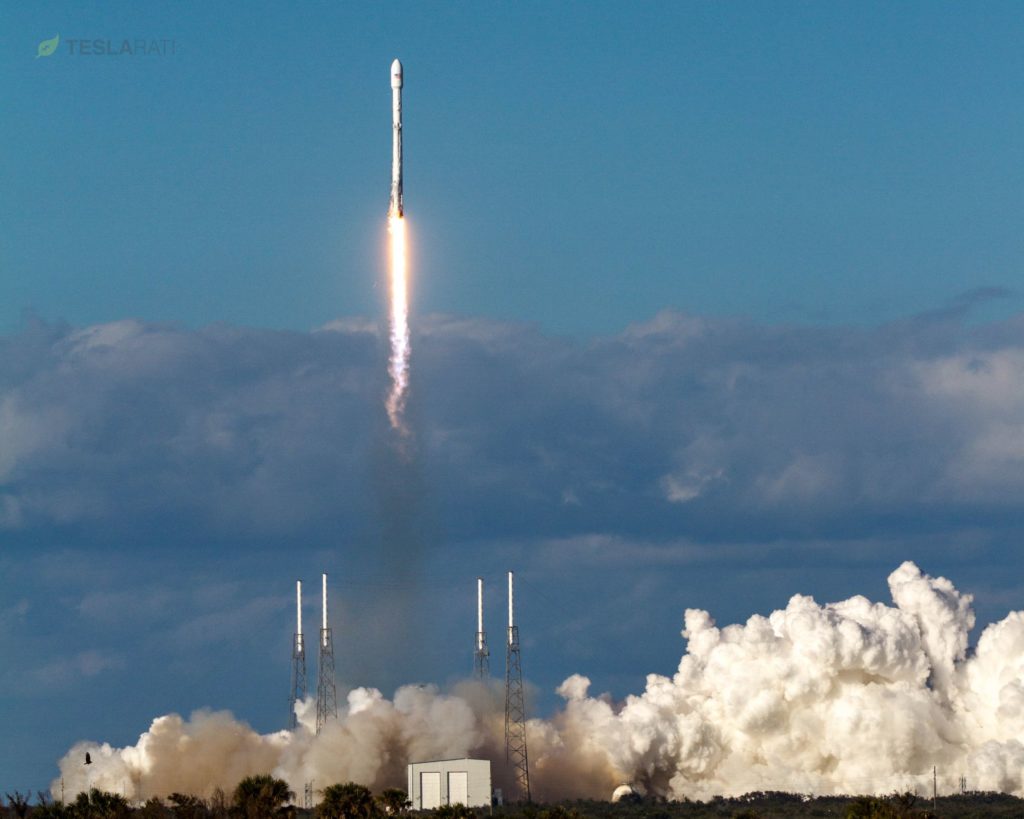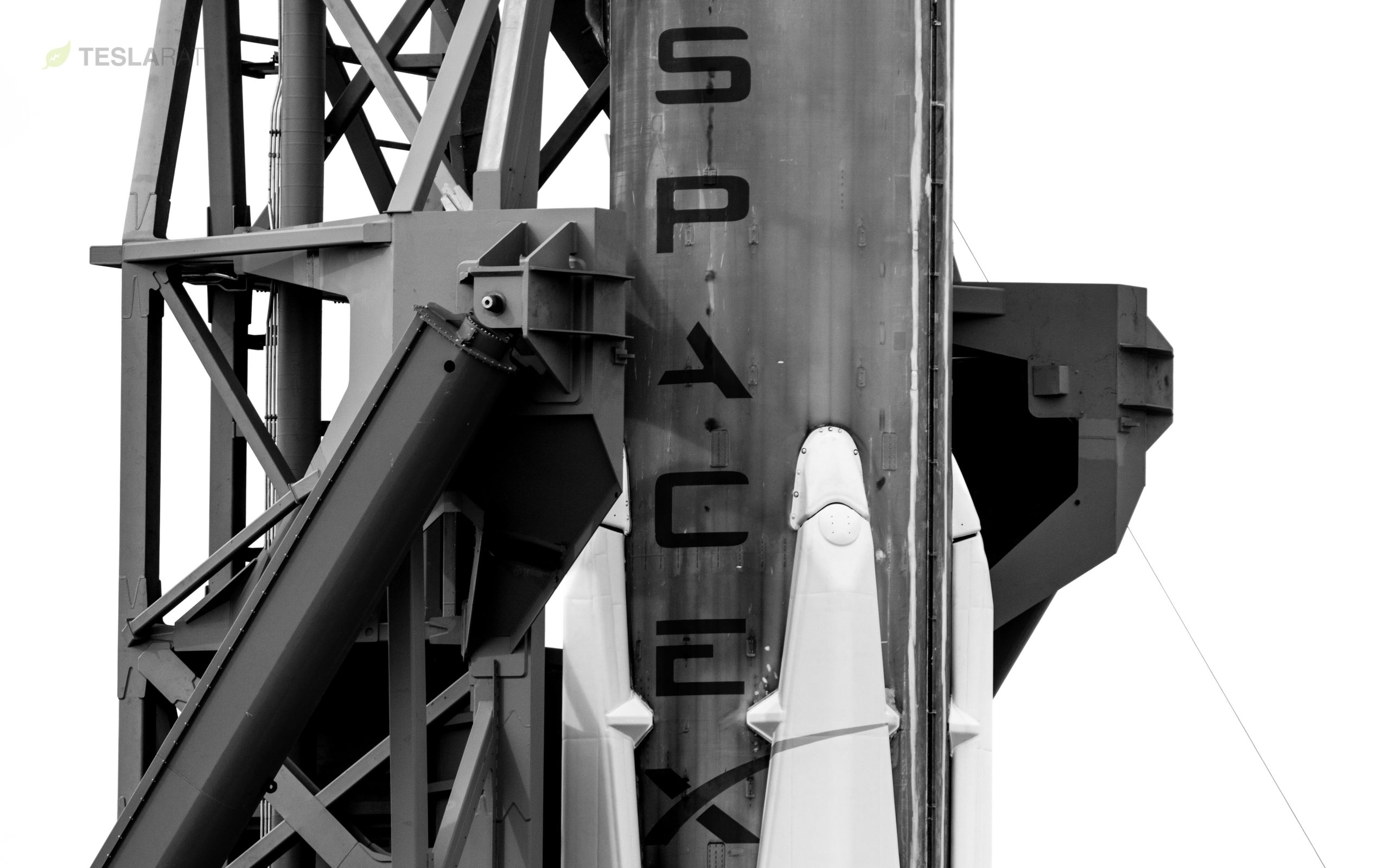
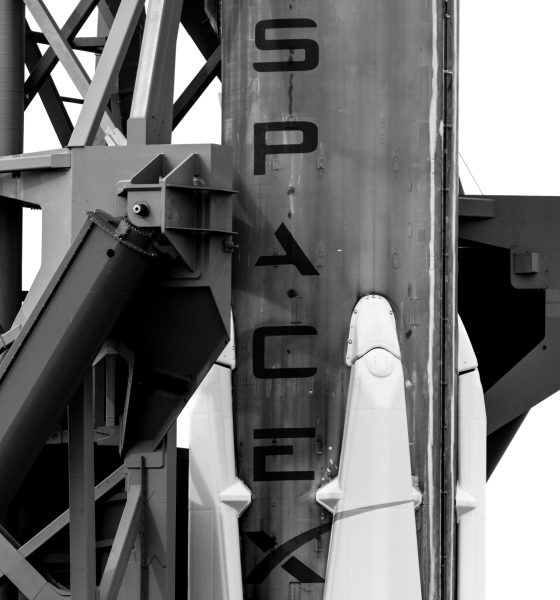
News
SpaceX nails reused booster launch, Falcon Heavy’s maiden flight days away
Despite a brief 24-hour delay due to weather and minor mechanical issues, SpaceX recycled the launch opportunity and completed the mission on Wednesday afternoon, January 31. Tasked with carrying GovSat-1 to orbit, the reused Falcon 9 rocket (Booster 1032) performed flawlessly and as expected, although the stage was expended. Launch directors confirmed just before the end of the live webcast that the communications satellite, a public-private partnership between SES and Luxembourg, was placed into a good orbit a few minutes before it separated from Falcon 9’s second stage. The mission marks SpaceX’s second successful launch of 2018, its first reused flight of the year, and the last launch before Falcon Heavy’s inaugural flight – currently scheduled for Tuesday, February 6.
Perhaps most intriguingly (or at least uniquely), the to-be-expended booster was still seen outfitted with both grid fins and landing legs at the launch pad, the new legs a stark white against the dark and sooty backdrop of the Falcon 9’s recycled booster. While SpaceX’s webcast host very explicitly stated at least three times that the first stage was not going to be recovered, careful listeners may have still caught snippets of the launch and recovery directors announcing different milestones as Falcon 9 S1 landed softly in the Atlantic Ocean. Similar to the recovery operations after the launch of Iridium-4 in December 2018, S1 flew as if it were landing aboard a drone ship, although in the case of this launch that theatricality extended even to landing legs.
- Falcon 9 venting before liftoff. (Tom Cross)
- We have liftoff! (Tom Cross)
- (Tom Cross)
While it may seem quite odd that SpaceX would choose to expend an entire, recoverable rocket, it is presumed that SpaceX is simply choosing to rid itself of a stock of older boosters incapable of flying more than once or twice – preparing for the introduction of the highly reusable Block 5 of Falcon 9, in other words. As stated by the webcast host, a SpaceX engineer, the company’s goal is for boosters to last “tens of launches in the short term, and hundreds or thousands of launches in the long term.” It is worth remembering that expending rocket boosters in the ocean (or even over land for Russia and China) is the status quo of all non-SpaceX rockets, and SpaceX has only just begun to perfect booster recovery and reuse – the first successful ocean recovery was completed less than two years ago. The very fact that it already feels odd or even wrong to “throw away” hardware into the ocean after launch is a testament to just how rapidly SpaceX have changed both the figurative and literal paradigms of orbital rocketry, and it is only a matter of time before the eminently persistent company ends the practice of expendable launches internally, if not globally.
Up next, Falcon Heavy
After yet another successful mission for SpaceX, the company’s Florida efforts will now briefly focus on the imminent inaugural launch of Falcon Heavy, the company’s newest and largest rocket. Loosely penciled in for liftoff on Tuesday, February 6, the massive vehicle will become the most powerful and capable operational rocket in the world, comparable only to the likes of NASA’s Saturn V and Space Shuttle, as well as the Soviet Union’s short-lived Energia. Regardless of its place against a historical backdrop of massive state-funded rockets, Falcon Heavy will by default become the most powerful commercial launch vehicle ever developed, and that title will almost certainly remain uncontested until 2020 at the absolute earliest. If or when the first and smallest version of NASA’s SLS rocket launches, likely also no earlier than 2020, the space agency may well take the crown back for a brief year or so. Regardless, SpaceX will likely be regularly launching Falcon Heavies and nearing the tail end of the development and testing of its much larger BFR rocket and spaceship.
Falcon Heavy will be the clearest progress yet towards such a massive rocket, and will provide SpaceX with invaluable experience and expertise as the only private company to ever operate a super heavy-lift launch vehicle (SHLLV). After a solid four weeks of near-constant testing, bug-fixing, and retesting, Falcon Heavy just days ago completed its first static fire, marking the first point in its history that all 27 of its first stage engines were simultaneously ignited. The data produced by that crucial test was apparently satisfactory, and Elon Musk just yesterday reiterated that the vehicle’s first launch was still targeting February 6.
- Paper rocket, meet the real deal. (SpaceX)
- Falcon Heavy and Falcon 9 in the distance, a tour de force of SpaceX’s breadth of accomplishment. (SpaceX)
Follow along live as launch photographer Tom Cross and your intrepid author cover these groundbreaking events live.
Teslarati – Instagram – Twitter
Tom Cross – Instagram
Eric Ralph – Twitter

News
Tesla FSD fleet is nearing 7 billion total miles, including 2.5 billion city miles
As can be seen on Tesla’s official FSD webpage, vehicles equipped with the system have now navigated over 6.99 billion miles.

Tesla’s Full Self-Driving (Supervised) fleet is closing in on almost 7 billion total miles driven, as per data posted by the company on its official FSD webpage.
These figures hint at the massive scale of data fueling Tesla’s rapid FSD improvements, which have been quite notable as of late.
FSD mileage milestones
As can be seen on Tesla’s official FSD webpage, vehicles equipped with the system have now navigated over 6.99 billion miles. Tesla owner and avid FSD tester Whole Mars Catalog also shared a screenshot indicating that from the nearly 7 billion miles traveled by the FSD fleet, more than 2.5 billion miles were driven inside cities.
City miles are particularly valuable for complex urban scenarios like unprotected turns, pedestrian interactions, and traffic lights. This is also the difference-maker for FSD, as only complex solutions, such as Waymo’s self-driving taxis, operate similarly on inner-city streets. And even then, incidents such as the San Francisco blackouts have proven challenging for sensor-rich vehicles like Waymos.
Tesla’s data edge
Tesla has a number of advantages in the autonomous vehicle sector, one of which is the size of its fleet and the number of vehicles training FSD on real-world roads. Tesla’s nearly 7 billion FSD miles then allow the company to roll out updates that make its vehicles behave like they are being driven by experienced drivers, even if they are operating on their own.
So notable are Tesla’s improvements to FSD that NVIDIA Director of Robotics Jim Fan, after experiencing FSD v14, noted that the system is the first AI that passes what he described as a “Physical Turing Test.”
“Despite knowing exactly how robot learning works, I still find it magical watching the steering wheel turn by itself. First it feels surreal, next it becomes routine. Then, like the smartphone, taking it away actively hurts. This is how humanity gets rewired and glued to god-like technologies,” Fan wrote in a post on X.
News
Tesla starts showing how FSD will change lives in Europe
Local officials tested the system on narrow country roads and were impressed by FSD’s smooth, human-like driving, with some calling the service a game-changer for everyday life in areas that are far from urban centers.

Tesla has launched Europe’s first public shuttle service using Full Self-Driving (Supervised) in the rural Eifelkreis Bitburg-Prüm region of Germany, demonstrating how the technology can restore independence and mobility for people who struggle with limited transport options.
Local officials tested the system on narrow country roads and were impressed by FSD’s smooth, human-like driving, with some calling the service a game-changer for everyday life in areas that are far from urban centers.
Officials see real impact on rural residents
Arzfeld Mayor Johannes Kuhl and District Administrator Andreas Kruppert personally tested the Tesla shuttle service. This allowed them to see just how well FSD navigated winding lanes and rural roads confidently. Kruppert said, “Autonomous driving sounds like science fiction to many, but we simply see here that it works totally well in rural regions too.” Kuhl, for his part, also noted that FSD “feels like a very experienced driver.”
The pilot complements the area’s “Citizen Bus” program, which provides on-demand rides for elderly residents who can no longer drive themselves. Tesla Europe shared a video of a demonstration of the service, highlighting how FSD gives people their freedom back, even in places where public transport is not as prevalent.
What the Ministry for Economic Affairs and Transport says
Rhineland-Palatinate’s Minister Daniela Schmitt supported the project, praising the collaboration that made this “first of its kind in Europe” possible. As per the ministry, the rural rollout for the service shows FSD’s potential beyond major cities, and it delivers tangible benefits like grocery runs, doctor visits, and social connections for isolated residents.
“Reliable and flexible mobility is especially vital in rural areas. With the launch of a shuttle service using self-driving vehicles (FSD supervised) by Tesla in the Eifelkreis Bitburg-Prüm, an innovative pilot project is now getting underway that complements local community bus services. It is the first project of its kind in Europe.
“The result is a real gain for rural mobility: greater accessibility, more flexibility and tangible benefits for everyday life. A strong signal for innovation, cooperation and future-oriented mobility beyond urban centers,” the ministry wrote in a LinkedIn post.
News
Tesla China quietly posts Robotaxi-related job listing
Tesla China is currently seeking a Low Voltage Electrical Engineer to work on circuit board design for the company’s autonomous vehicles.

Tesla has posted a new job listing in Shanghai explicitly tied to its Robotaxi program, fueling speculation that the company is preparing to launch its dedicated autonomous ride-hailing service in China.
As noted in the listing, Tesla China is currently seeking a Low Voltage Electrical Engineer to work on circuit board design for the company’s autonomous vehicles.
Robotaxi-specific role
The listing, which was shared on social media platform X by industry watcher @tslaming, suggested that Tesla China is looking to fill the role urgently. The job listing itself specifically mentions that the person hired for the role will be working on the Low Voltage Hardware team, which would design the circuit boards that would serve as the nervous system of the Robotaxi.
Key tasks for the role, as indicated in the job listing, include collaboration with PCB layout, firmware, mechanical, program management, and validation teams, among other responsibilities. The role is based in Shanghai.
China Robotaxi launch
China represents a massive potential market for robotaxis, with its dense urban centers and supportive policies in select cities. Tesla has limited permission to roll out FSD in the country, though despite this, its vehicles have been hailed as among the best in the market when it comes to autonomous features. So far, at least, it appears that China supports Tesla’s FSD and Robotaxi rollout.
This was hinted at in November, when Tesla brought the Cybercab to the 8th China International Import Expo (CIIE) in Shanghai, marking the first time that the autonomous two-seater was brought to the Asia-Pacific region. The vehicle, despite not having a release date in China, received a significant amount of interest among the event’s attendees.
